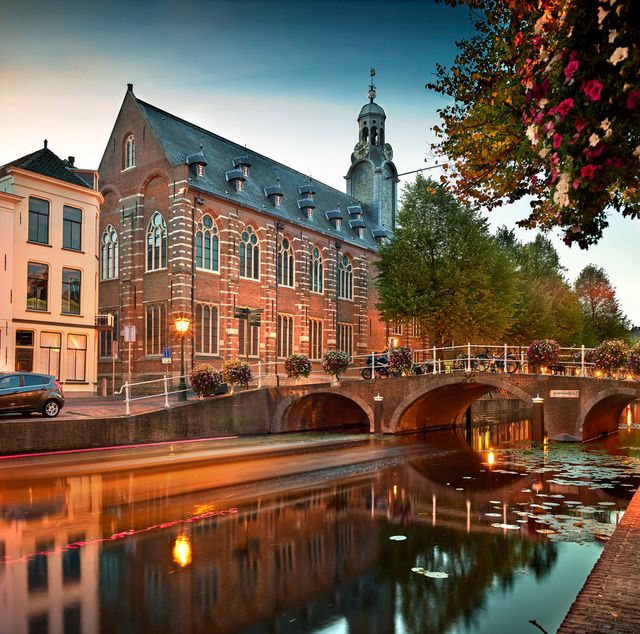Journey into the past
The story of Leiden

The story of Leiden
The history of Leiden goes back a long way. At the end of the fifteenth century, the city was the largest in the County of Holland, which was primarily due to the international textile industry. Everything changed from the sixteenth century, a time of reforms and persecutions. In 1572, Leiden joined the Dutch revolt against Spanish rule and was besieged twice by the Spanish.
Relief of Leiden - 3 October 1574
The Spanish wanted to starve the city into submission and pitched camp around Leiden. The inhabitants became sick and were starving to death; would the city fall into the hands of the Spanish? Flooding a large part of Zuid-Holland enabled the rebel Watergeuzen (‘Sea Beggars’) to liberate the city, where they handed out herring and white bread. On the 3rd of October 1574 the Spanish troops fled, leaving just a little food behind: a cooking pot containing hutspot (a mash of parsnips, carrots, meat and onions). Every year on the 3rd of October the city celebrates the Relief of Leiden with a two-day party, with much music, a large funfair, fireworks, and of course handing out herring and white bread to the residents of the city. The traditional hutspot (with potatoes instead of parsnips nowadays) is also an essential part of the celebrations!
The story goes that because the people of Leiden had held out for so long, William of Orange gave the city the first university of the Netherlands.
The Relief of Leiden marked the beginning of a new period of growth. In 1577, tens of thousands of people from the southern Netherlands migrated to Leiden because of their Calvinistic faith. These experienced textile workers, employed in what is now Museum De Lakenhal, gave a boost to the city's ailing wool industry with new products, techniques, capital and labour. Leiden also developed as a city of letters: it was an important centre for printers, academic publishers and bookshops.
Leiden grew to become the second-largest city of the Republic, after Amsterdam. The population continued to increase and the city was enlarged in 1611, 1644 and 1659, giving the Singelring (Outer Canal) its present shape. In its heyday around 1670, over 60,000 people lived packed together in the city. This period in the seventeenth century is often called the Golden Age of the Netherlands.
Leiden University
On 8 February 1575, in the renowned Pieterskerk, Leiden was given the first university in the Netherlands. This was a reward from William of Orange for resisting the Spanish siege and marked the start of many discoveries made in Leiden — a city where freedom in word, science and culture have come together to form a true City of Discoveries. Within 75 years Leiden University had grown to become a ‘Wonder of Europe’, one of the most important universities. Did you know that the official foundation certificate can still be seen in the University Library?

Decline and revolution
In the eighteenth century the Leiden wool industry went into a gradual decline, employment shrank and the city was emptying. Discontent was growing, a situation that was not helped by the Napoleonic Wars that continued to drag on. To cap it all, the city centre was hit by disaster through the explosion of a gunpowder ship on 12 January 1807. Dozens of houses were destroyed and no fewer than 160 lives lost.
19th century
After 1815, the fortunes of the city changed for the better once more. New industries grew up in the city, such as metalworking, graphic design and food canning. This period of prosperity can still be seen in the façades on the elegant shopping streets.
'City of knowledge and culture'
In the last thirty years the city has yet again changed for the better. From an impoverished manufacturing city in the 1960s and the departure of industry in the 1980s, Leiden has now become a true city of knowledge and culture. In this City of Discoveries, new discoveries are still being made on a daily basis.
The city is home to the Leiden Bio Science Park, the Netherlands’ largest innovation district in the field of life sciences and health. There is also a research university, a university of applied sciences, and a senior secondary vocational training institution, where more than 32,000 students in total are studying.
Leiden is a city where the historical culture can be constantly seen and felt.
Keys of Leiden - Leiden, City of Keys
Why do you see keys all over the city, and what do they mean? Since 1293, official documents of the ‘City of Leyde’ increasingly began to feature a city seal showing the Apostle Peter as the patron saint of the city. In the Gospel of Matthew we read that Peter was ‘given the keys of the Kingdom of Heaven’, which is why Peter is portrayed holding a key. The well-known Pieterskerk bears his name and it is the reason why the city's coat of arms and flag show two crossed keys.
